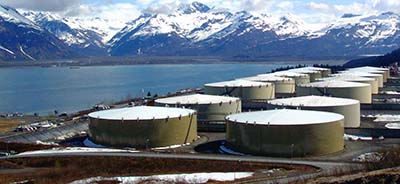By LINDA SWISS
Council Project Manager

The oil spill contingency plan for the Valdez Marine Terminal is undergoing an update, and the council recently had an opportunity to comment on the changes.
The plan, known officially as the Valdez Marine Terminal Oil Discharge Prevention and Contingency Plan, contains detailed information about how an oil spill at the terminal can be contained and cleaned up, and ways to prevent an oil spill in the first place.
By law, these plans are required to be reviewed and updated every five years, and these changes are a part of that regular cycle.
The Oil Pollution Act of 1990, enacted by Congress after the Exxon Valdez oil spill, directs the council to review and make recommendations when the plans are updated.
Complex rewrite
Originally, for this review, the plan was set to expire in May 2013. However, during this review cycle, the plan ended up being extensively rewritten. Three deadline extensions were granted by the Alaska Department of Environmental Conservation, in order to review proposed changes and provide feedback. The current plan is now set to expire in December 2014. These extensions, totaling 18 months, illustrate how complex the review has been.
Council recommendations
The council provided extensive comments during the 30-day public review period. The plan describes both prevention and response activities at the terminal. Yet due to concerns about the age of the terminal facility, the council paid particular attention to prevention.
The council believes that preventing an oil spill from occurring in the first place is the most effective strategy to protect human health and the environment.
The council supports physical inspections of all above and below ground piping at the terminal, ensuring that the plan includes robust descriptions of facility piping segments, and increased monitoring of pipeline integrity.
A secondary containment system surrounds all crude oil tanks at the terminal to catch oil and prevent spills from reaching the nearby environment. The council supports verifying that the containment system’s catalytically blown asphalt liner is sufficiently impermeable to protect groundwater, as required. The council is concerned whether, after 35 years of use, this liner remains intact. Alyeska receives a “prevention credit,” based on the integrity of secondary containment, which allows Alyeska to plan for a spill that is much smaller than the total capacity at the terminal. That means less response equipment would be required by the plan.
Other recommendations include:
- Limiting internal inspection cycle of crude oil tanks to no more than 10 years
- Ensuring major equipment, such as barges and fishing vessels, are available when needed
- Conducting a risk assessment on the entire terminal facility
While the contingency plan goes through the official State of Alaska review process and approval, federal agencies also play a part in reviewing and approving this plan. The council has directed comments to all agencies involved.
Please see our Executive Director’s column for more on the council’s recommendations for improving the terminal contingency plan.